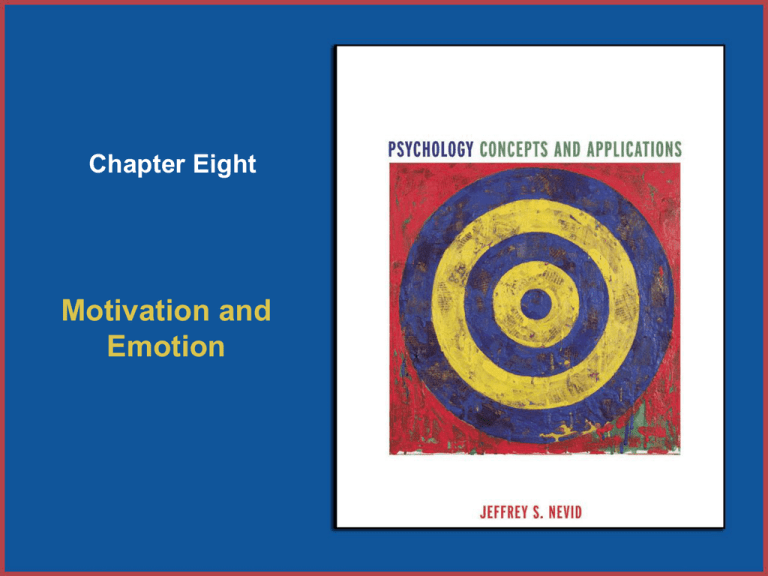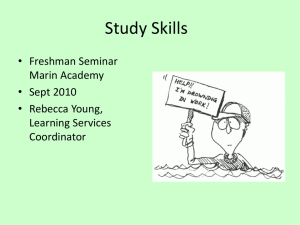
Chapter Eight
Motivation and
Emotion
Copyright © Houghton Mifflin Company. All rights reserved.
8–1
Did You Know That…
• The founding father of American psychology
believed there is a human instinct for
cleanliness?
• According to a leading psychological theory, if
you had to wait in line for hours to purchase
tickets for a concert, you would probably rate
the event as more enjoyable than you would
if the tickets had been easy to come by?
Copyright © Houghton Mifflin Company. All rights reserved.
8–2
Did You Know That… (cont.)
• A researcher once swallowed a balloon to
test the theory that stomach contractions
signal hunger?
• The adult weight of people who were adopted
as babies is closer to the weight of their
biological parents than to the weight of the
parents who raised them
Copyright © Houghton Mifflin Company. All rights reserved.
8–3
Did You Know That… (cont.)
• Obese people typically have more fat cells
than people of normal weight have?
• Practicing smiling can lift your mood?
• There is no emotion center in the brain?
• Responding without thinking can be a
lifesaver in some situations?
Copyright © Houghton Mifflin Company. All rights reserved.
8–4
Module 8.1
Motivation: The “Why’s” of Behavior
Copyright © Houghton Mifflin Company. All rights reserved.
8–5
Module 8.1 Preview Questions
•
•
•
•
What is motivation?
What is instinct theory?
What is drive theory?
How does arousal theory account for
differences in motivational states?
• How does incentive theory differ from drive
theory?
Copyright © Houghton Mifflin Company. All rights reserved.
8–6
Module 8.1 Preview Questions
(cont.)
• What is cognitive dissonance theory?
• What are psychosocial needs?
• What is Maslow’s hierarchy of needs?
Copyright © Houghton Mifflin Company. All rights reserved.
8–7
What Is Motivation?
• Factors that activate, direct, and sustain goaldirected behaviors.
• Motives: Needs or wants that drive goaldirected behavior.
– Cannot be observed, must be inferred.
Copyright © Houghton Mifflin Company. All rights reserved.
8–8
Biological Sources of Motivation:
Instinct Theory
• Instinctive Behaviors: Fixed, inborn patterns
of response that are specific to members of a
particular species.
• Instinct Theory: All behavior is motivated by
instinct.
• Problems with instinct theory:
– List of instincts grew too long to be useful.
– Instincts label, but don’t explain.
– Human behavior is too variable and flexible.
Copyright © Houghton Mifflin Company. All rights reserved.
8–9
Biological Sources of Motivation:
Drive Theory
• Need: State of deprivation or deficiency.
• Drive: State of bodily tension.
• Drive reduction motivates behavior
– Based on homeostasis
• Types of drives:
– Primary Drives: Arise from basic biological needs.
– Secondary Drives: Learned or acquired through
experience.
Copyright © Houghton Mifflin Company. All rights reserved.
8–10
Biological Sources of Motivation:
Arousal Theory
• Stimulus Motives: Biologically based needs
for exploration and activity.
• Arousal Theory: Organism seeks way to
maintain optimal level of arousal.
– Sensation-seekers have a high need for arousal.
– Optimal levels of arousal vary from time to time.
Copyright © Houghton Mifflin Company. All rights reserved.
8–11
Figure 8.1: Yerkes-Dodson Law
Copyright © Houghton Mifflin Company. All rights reserved.
8–12
Psychological Sources of Motivation:
Incentive Theory
• Incentives: Rewards or other stimuli that
motivate us to act.
• Incentive Value: Strength of “pull” exerted by
goal or reward.
• Incentive values influenced by many factors:
– e.g., one’s learning experiences and
expectancies.
– Also determined in part by cultural influences.
Copyright © Houghton Mifflin Company. All rights reserved.
8–13
Psychological Sources of Motivation:
Cognitive Dissonance
• Cognitive Dissonance: Unpleasant state of
tension when attitude and behavior are
inconsistent.
• Cognitive Dissonance Theory: People are
motivated to reduce dissonance by making
behaviors and attitudes compatible.
• Effort Justification: Tendency to justify the
effort expended in attaining difficult goals.
Copyright © Houghton Mifflin Company. All rights reserved.
8–14
Figure 8.2: Ways of Reducing
Cognitive Dissonance
Copyright © Houghton Mifflin Company. All rights reserved.
8–15
Psychological Sources of Motivation:
Psychosocial Needs
• Need for social relationships or need for
affiliation.
• Need for achievement
– Extrinsic Motivation: Desire for external rewards.
• Driven by performance goals.
– Intrinsic Motivation: Desire for internal gratification.
• Driven by learning goals.
• Achievement motivation vs. avoidance
motivation
Copyright © Houghton Mifflin Company. All rights reserved.
8–16
Figure 8.3:
Maslow’s Need Hierarchy
Copyright © Houghton Mifflin Company. All rights reserved.
8–17
Module 8.2
Hunger and Eating
Copyright © Houghton Mifflin Company. All rights reserved.
8–18
Module 8.2 Preview Questions
•
•
•
•
•
How are hunger and appetite regulated?
What causes obesity?
What is anorexia nervosa?
What is bulimia nervosa?
What are the causes of eating disorders?
Copyright © Houghton Mifflin Company. All rights reserved.
8–19
Figure 8.4: Classic Experiment on
Stomach Contractions and Hunger
Copyright © Houghton Mifflin Company. All rights reserved.
8–20
Figure 8.5: Parts of the Hypothalamus
Involved in Hunger and Eating
Copyright © Houghton Mifflin Company. All rights reserved.
8–21
Brain Chemicals and Hunger
• Neuropeptide Y: Stimulates appetite and
eating.
• Leptin: Curbs appetite and eating.
• Dopamine & Endorphins: Responsible for
feelings of pleasure associated with eating?
• Serotonin: Responsible for feelings of
satiety?
Copyright © Houghton Mifflin Company. All rights reserved.
8–22
Obesity
• A state of excess body fat.
• Common and increasing in frequency
– About 60% of Americans are overweight
– About 26% of Americans are obese
• A major health risk
• Measured by body mass index (BMI)
– Height and weight taken into account
Copyright © Houghton Mifflin Company. All rights reserved.
8–23
Causes of Obesity
• Behavioral patterns
– Consuming too many calories
– Insufficient exercise
• Hereditary and biological factors
– Slower metabolism
– Set Point Theory: Brain regulates body weight
around predetermined set point.
– Number of fat cells
• Environmental factors
• Emotional states
Copyright © Houghton Mifflin Company. All rights reserved.
8–24
Table 8.1: Suggestions for
Maintaining a Healthy Weight
•
•
•
•
•
Limit fat intake.
Control portion size.
Slow down the pace of eating.
Beware of hidden calories.
Make physical activity a part of your lifestyle.
Copyright © Houghton Mifflin Company. All rights reserved.
8–25
Losing Weight
•
•
•
•
Consume fewer calories than expended
One pound = 3,500 calories
Balance eating and exercise
Problem with “quickie” diets
– Tend to be temporary weight loss only
– Drugs may have serious side effects
Copyright © Houghton Mifflin Company. All rights reserved.
8–26
Eating Disorders
• Anorexia nervosa
– Self starvation, dangerously low body weight
– Medical dangers
– Typically young women
• Bulimia nervosa
– Binge eating followed by purging
– Typically maintains normal body weight
– Medical complications
Copyright © Houghton Mifflin Company. All rights reserved.
8–27
Causes of Eating Disorders
• Cultural factors
– Pressure for unrealistic standards of thinness
– Dieting as a normative eating pattern
Copyright © Houghton Mifflin Company. All rights reserved.
8–28
Figure 8.7: The Thinning of the Ideal
Feminine Figure
Source: Data based on Rubinstein, S., & Caballero, B. (2000). Is Miss America an undernourished role
model? Journal of the American Medical Association, 283, 1569.
Copyright © Houghton Mifflin Company. All rights reserved.
8–29
Figure 8.8:
Gender Differences in Obesity
Source: National Heart, Lung, and Blood Institute, National Institutes of Health (1993, March) Data fact
sheet: Obesity and Cardiovascular disease. Bethesda, MD: Author.
Copyright © Houghton Mifflin Company. All rights reserved.
8–30
Causes of Eating Disorders
• Psychological factors
– Issues of control and perfectionism
– History of abuse or family conflict
• Biological factors
– Disturbances in brain mechanisms controlling
hunger and satiety
– Irregular serotonin activity
Copyright © Houghton Mifflin Company. All rights reserved.
8–31
Module 8.3
Emotions
Copyright © Houghton Mifflin Company. All rights reserved.
8–32
Module 8.3 Preview Questions
• What are the three components of emotions?
• Are facial expressions of emotion universal?
• What role do brain structures play in
emotions?
• What are the major theories of emotion?
• What are the three components of love in
Sternberg’s model of love?
• What is the polygraph?
Copyright © Houghton Mifflin Company. All rights reserved.
8–33
What Are Emotions?
• Feeling states that have three components:
– Bodily arousal
– Cognition
– Expressed behavior
Copyright © Houghton Mifflin Company. All rights reserved.
8–34
Figure 8.9: Cross-Species Similarity
in Facial Expression
Copyright © Houghton Mifflin Company. All rights reserved.
8–35
Six Basic Emotional Expressions
•
•
•
•
•
•
Anger
Fear
Disgust
Sadness
Happiness
Surprise
Copyright © Houghton Mifflin Company. All rights reserved.
8–36
Figure 8.10:
Plutchik’s
Color Wheel
of Emotions
Copyright © Houghton Mifflin Company. All rights reserved.
8–37
What Emotion Is
This Person Portraying?
•
•
•
•
Copyright © Houghton Mifflin Company. All rights reserved.
Disgust
Sadness
Happiness
Anger
8–38
What Emotion Is
This Person Portraying?
•
•
•
•
Copyright © Houghton Mifflin Company. All rights reserved.
Disgust
Sadness
Happiness
Anger
8–39
What Emotion Is
This Person Portraying?
•
•
•
•
Copyright © Houghton Mifflin Company. All rights reserved.
Disgust
Sadness
Happiness
Anger
8–40
What Emotion Is
This Person Portraying?
•
•
•
•
Copyright © Houghton Mifflin Company. All rights reserved.
Disgust
Sadness
Happiness
Anger
8–41
Cultural Differences in Emotions
• Cultural variation in how emotions are
experienced and displayed.
• Display Rules: Cultural customs and norms
that regulate the display of emotion.
• Cultural differences in gestures and bodily
movements.
Copyright © Houghton Mifflin Company. All rights reserved.
8–42
Facial-Feedback Hypothesis
• Belief that mimicking facial movements will
induce an emotion.
• Duchenne Smile: A genuine smile that
involves contraction of a particular set of
facial muscles.
Copyright © Houghton Mifflin Company. All rights reserved.
8–43
Where Do Emotions Reside?
• Autonomic nervous system
• Limbic system
– Amygdala: Evaluates whether stimuli is a threat.
– Hypothalamus: Triggers release of hormones.
– Hippocampus: Processes information about
context emotional response occurred.
• Cerebral cortex
– Possible hemispheric differences in processing of
emotions.
Copyright © Houghton Mifflin Company. All rights reserved.
8–44
Theories of Emotion:
James-Lange Theory
• Bodily reactions precede emotions.
• Emotions occur after sensing a particular
pattern of bodily arousal.
• Example: feel afraid because of trembling,
pounding heart, rapid breathing
Copyright © Houghton Mifflin Company. All rights reserved.
8–45
Theories of Emotion:
Cannon-Bard Theory
• Subjective experience and bodily reactions
occur simultaneously.
• Example: experience fear and trembling,
pounding heart at the same time
Copyright © Houghton Mifflin Company. All rights reserved.
8–46
Theories of Emotion:
Schacter’s Two-Factor Model
• Emotional experiences depend on:
– State of general arousal and
– Cognitive interpretation (labeling) of the causes of
arousal.
• Doesn’t account for distinctive physiological
features of different emotions.
Copyright © Houghton Mifflin Company. All rights reserved.
8–47
Theories of Emotion:
Dual-Pathway Model of Fear
• Two brain pathways to process fear
messages.
• Thalamus to cerebral cortex pathway
– Careful processing of information
• Pathway direct to amygdala
– Allows faster response to danger cues
Copyright © Houghton Mifflin Company. All rights reserved.
8–48
Figure 8.12:
LeDoux’s
DualPathway
Model of
Fear
Source: Adapted from LeDoux,
J. (1996). The emotional brain.
New York: Touchstone.
Copyright © Houghton Mifflin Company. All rights reserved.
8–49
Figure 8.13: Theoretical Models of Fear
Copyright © Houghton Mifflin Company. All rights reserved.
8–50
Love: The Deepest Emotion
• Love is considered to be both a motive and
an emotion.
• Romantic love idealized in Western culture.
– But not limited to Western culture.
Copyright © Houghton Mifflin Company. All rights reserved.
8–51
Figure 8.14:
Sternberg’s Triangular Model of Love
Copyright © Houghton Mifflin Company. All rights reserved.
8–52
Copyright © Houghton Mifflin Company. All rights reserved.
8–53
Characteristics of
Emotional Intelligence
•
•
•
•
•
Knowing your emotions
Managing your emotions
Motivating yourself
Recognizing emotions in others
Handling relationships
Copyright © Houghton Mifflin Company. All rights reserved.
8–54
The Polygraph
• Device used to detect whether people are
lying.
• Measures physiological arousal thought to
correspond to lying.
– Electrical reactivity of skin
– Respiration
– Heart rate
• Criticized because of reliability problems.
Copyright © Houghton Mifflin Company. All rights reserved.
8–55
Module 8.4
Application: Managing Anger
Copyright © Houghton Mifflin Company. All rights reserved.
8–56
Module 8.4 Preview Question
• What can you do to control your anger?
Copyright © Houghton Mifflin Company. All rights reserved.
8–57
Cognitive Theory on Managing Anger
• Situations do not cause anger.
• Anger is caused by a person’s reaction to a
situation.
– Angry thoughts
– Anger-inducing self-statements
• How can control anger?
– Identify and correct thoughts and statements
Copyright © Houghton Mifflin Company. All rights reserved.
8–58
Suggestions for Anger
Management
• Become aware of your emotional reactions in
anger-provoking situations.
• Review the evidence.
• Practice more adaptive thinking.
• Engage in competing responses.
• Don’t get steamed.
Copyright © Houghton Mifflin Company. All rights reserved.
8–59
Suggestions for Anger
Management (cont.)
• Oppose anger with empathy.
• Congratulate yourself for responding
assertively rather than aggressively.
• Scale back your expectations of others.
• Modulate verbal responses.
• Learn to express positive feelings.
Copyright © Houghton Mifflin Company. All rights reserved.
8–60







